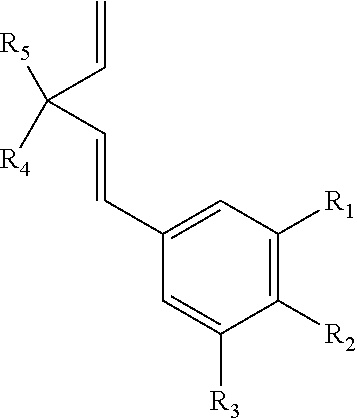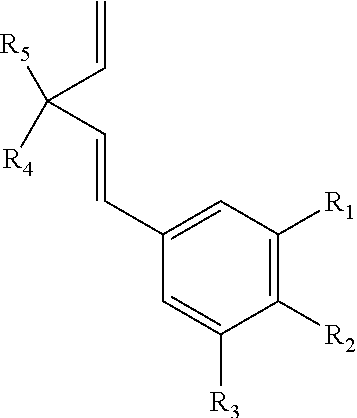Sunscreen compositions and methods
a technology of compositions and sunscreens, applied in the field of sunscreen compositions, to achieve the effect of preventing damage due, reducing the manifestation of said damage, and improving stability and utility
- Summary
- Abstract
- Description
- Claims
- Application Information
AI Technical Summary
Benefits of technology
Problems solved by technology
Method used
Image
Examples
example 1
Reduction of UV-Induced Erythema
[0082]Erythema, the most familiar manifestation of UV radiation exposure, occurs in a biphasic manner. UV-A mediates the early part of this reaction, known as immediate pigment darkening (IPD) and lasts for about half-hour. Delayed erythema, a function primarily of UV-B dosages, begins 2-8 hours after exposure and reaches a maximum in 24-36 hours, with erythema, pruritius, and pain in the sun-exposed areas.
[0083]Microscopically, changes are detectable as early as 30 minutes after UV radiation exposure. Epidermal changes include intracellular edema, vacuolization and swelling of melanocytes, and the development of characteristic sunburn cells. In the dermis, UV radiation initially leads to interstitial edema and endothelial cell swelling. Later, there is perivenular edema, degranulation, and toss of mast cells, a decrease in the number of Langerhans cells, neutrophil infiltration, and erythrocyte extravasation.
[0084]In order to evaluate the anti-erythe...
example 2
Collagenase Inhibitory Activity
[0088]In order to ascertain whether other benefits may be attained by the use of meroterpenes in sunscreen formulations, a study was conducted on the impact, if any, the presence of bakuchiol may have on collagenase: a collagenolytic enzyme responsible for much of the collagen damage associated with UV exposure and photoaging in general. Collagenase activity was measured with an Enzcheck kit from Molecular Probes (Carlsbad, Calif., USA) using quenched fluorescent gelatin and Clostridium collagenase IV, a generic metalloproteinase. Test material (aqueous solutions 1000 ug / ml, 100 ug / ml, 10 ug / ml and 1 ug / ml made from 10 mg / ml stock in DMSO) was incubated in the presence of collagenase substrate—quenched fluorescin-linked gelatin and in the presence of the proteolytic enzyme. Phenanthroline, a potent metalloprotease (MP) inhibitor was used as positive control at 100 ug / ml. The kinetics of the release of the digested, fluorescent gelatin were measured at ...
example 3
Skin Sensitivity
[0090]Given the known sensitivity issues associated with commercial grade bakuchiol, evaluation of the skin sensitivity to the purified bakuchiol was also evaluated. Skin sensitivity was evaluated following the method cited in the reference Appraisal of the Safety Chemicals in Food, Drugs and Cosmetics, published by The Association of Food and Drug Officials of The United States. The method employs nine inductive patching and not the ten cited in the reference under occlusive patch conditions.
[0091]Samples were prepared for evaluation by diluting the purified Bakuchiol in corn oil to a 5% concentration, with dilutions freshly. prepared on each application day. 0.2 ml or 0.2 g of the diluted test material was dispensed onto the occlusive, hypoallergenic patch and the treated patch applied directly to the skin of the infrascapular regions of the back, to the right or left of the midline of each subject: one hundred and eleven subjects were employed. After application o...
PUM
| Property | Measurement | Unit |
|---|---|---|
| weight percent | aaaaa | aaaaa |
| particle size | aaaaa | aaaaa |
| particle size | aaaaa | aaaaa |
Abstract
Description
Claims
Application Information
 Login to View More
Login to View More - R&D
- Intellectual Property
- Life Sciences
- Materials
- Tech Scout
- Unparalleled Data Quality
- Higher Quality Content
- 60% Fewer Hallucinations
Browse by: Latest US Patents, China's latest patents, Technical Efficacy Thesaurus, Application Domain, Technology Topic, Popular Technical Reports.
© 2025 PatSnap. All rights reserved.Legal|Privacy policy|Modern Slavery Act Transparency Statement|Sitemap|About US| Contact US: help@patsnap.com



